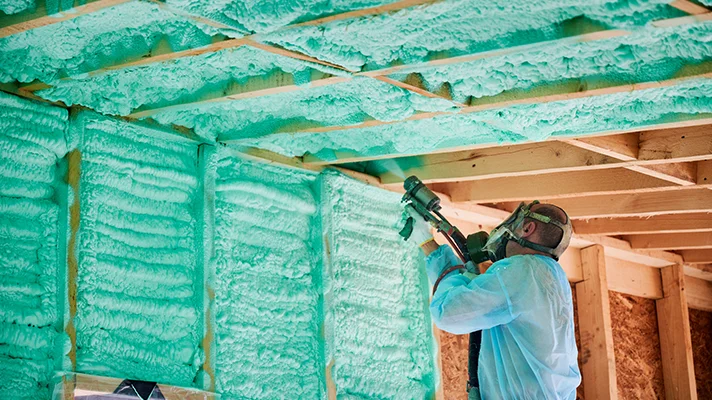Secure your future today!
Sprayed Polyurethane Foam Hazards and Controls

Spray Polyurethane Foam (SPF) is a foam insulation used to insulate spaces and maintain either cold or heat temperatures depending on the need. SPF is found on interior walls and ceilings, cold storage rooms, coolers, controlled-atmosphere rooms, general barns, and pole barns. SPF is flexible and can be applied to wood, metal, or masonry surfaces.
What are the hazards and risks of SPF insulation?
If it catches on fire, exposed SPF can cause more damage to a building, more extensive smoke damage to contents, and delays in firefighter response if firefighters cannot enter the building because of heavy smoke development.
While difficult to ignite directly, SPF can produce heavy smoke when exposed to a flame or heat from other fire sources. SPF fires can be short and less severe when no other material is involved. However, most structures have fuel loads that are likely to contribute to a fire.
In situations where SPF is exposed to heat for shorter durations (like a trash fire, welding torch, or hot metal), unprotected SPF can ignite and result in a flash fire. These fires are shorter in duration and produce a layer of char over the foam that is less combustible, but which still produces dangerous gas and heavy smoke that can damage contents and that will hinder firefighters.
In confined areas, combustible gases can accumulate. This can cause flashover and result in a quick spreading fire if the gas ignites. If heat and gases rise to the level of approximately 7000 degrees Fahrenheit, the initial char will provide less protection to foam underneath. It may begin contributing fuel to the fire, along with additional foam or other combustible material.
What foam is acceptable?
Unless proven otherwise, SPF should be treated as combustible material. Older foam applications should be suspect unless documentation can be produced.
The Spray Polyurethane Foam Alliance (SPFA) recommends foam that meets ASTM 84 Standard Test Methods for Surface Burning Characteristics of Building Material. It should have a Flame Spread Index (FSI) of 75 or less and Smoke Development Index (SDI) of 450 or less.
Note that SPFA ratings are based on laboratory conditions and not true fire situations. Even SPF with fire retardant contains organic material and will burn. One study reports the main goal of retardant is to assist with building evacuation.
What are approved thermal barriers?
Thermal barriers can both reduce the potential for the SPF to be involved in a fire and that delay smoke development. Building codes require thermal barriers in habitational buildings. Thermal barriers are intended to limit the temperature rise in SPF to not more than 250 degrees after being exposed to a fire for 15 minutes. These thermal barriers are called 15-minute thermal barriers and may also be classified as having an index of 15.
Approved thermal barriers have the equal fire resistance of 1/2 inch gypsum board. Other barriers are called ignition barriers; these do not provide the same level of protection as true thermal barriers. They may be considered acceptable in attics and crawl spaces, but do not provide the same level of protection as a true thermal barrier. Types of thermal barriers include:
Gypsum wallboard provides the best thermal barrier. It requires framework to attach and is more difficult and expensive to install. Wallboard is also susceptible to damage from forklifts or impact.
Engineered panels are made of a sandwich of metal and foam and are designed to meet requirements for limited flame spread and smoke development. They are typically found in buildings that were constructed specifically for coolers and cold-storage situations.
Engineered panels are designed and tested to meet 15-minute thermal barrier ratings. Plain corrugated metal panels can transmit heat to foam underneath and are not thermal barriers.
Spray-on or rolled-on cementitious materials are similar to sprayed or rolled fire retardant applications on structural steel. They are easier to apply but must be thick enough to provide required protection and cover all areas properly. Therefore, only trained contractors should apply the material.
Fire-treated plywood resists impact better than wallboard. Fire-retardant material can degrade over time and also requires a frame to attach to. It can be used at lower levels to resist impact with gypsum wallboard at higher levels.
Thermal barriers should be installed by qualified contractors who are familiar with the products in order to achieve the proper thickness, cover all of SPF, and properly seal seams.
Controls for Dealing with Spray Polyurethane Foam
These practices and controls should be applied:
- If SPF is noted and no thermal barriers are applied, contact a licensed building contractor to determine the best thermal barrier and method to cover the foam.
- Identify any other fuel loads in the building like idle pallets, crates, or packing material. Minimize indoor storage and maintain good housekeeping practices to minimize the amount of combustible material that could contribute to a fire.
- Control potential ignition sources. These can include proper electrical installation and maintenance, forklifts, following a hot work permit program if welding, and following a no smoking policy.
- Apple storage facilities may have controlled atmosphere rooms where the oxygen level is lowered to store apples. Controlled atmosphere (CA) rooms typically have sensors to monitor temperature and atmosphere conditions in the rooms. These can be read from the outside of the room orsignal to an outside source if conditions in the room change. While the oxygen may be too lowto support a fire in one room, not all of the rooms may be used at the same time, so a fire could spread in unused rooms. There may also be common building areas outside of the CA rooms where a fire could develop until the walls are breached and allow oxygen to enter the rooms. Therefore, covering SPF in CA rooms is also an important control.
Download This Article
Additional Safety Topics
Check Out All Our Products
Commercial Insurance Built for You
We offer a wide range of Commercial insurance products. Find the product that's right for you!
Specialty Insurance
Commercial Auto Insurance Workers' Compensation Insurance Manufacturing Insurance Insurance for WineriesConstruction and Contracting
General Contractor Insurance Carpenters Insurance Plumbing Insurance Excavator Insurance Electrician Insurance HVAC Business Insurance Lawn Care Business InsuranceRetail and Service
Retail Business Insurance Barber Insurance Pet Grooming Insurance Florist Insurance Bakery Insurance Photographer Insurance Beautician Insurance Coffee Shop Insurance Funeral Home Insurance Janitorial InsuranceGet Insurance for Your Car and Home
You need to protect more than just your business. Get insurance for your personal property too!
Personal Lines InsuranceWe've Got You Covered!
We offer Personal Lines Insurance in five states: Ohio, Michigan, Illinois, Indiana, and Wisconsin.
Insurance for All Types of Farms
Hastings offers a range of products specifically designed for farmers.
Farm InsuranceWe've Got You Covered!
We offer Farm Lines Insurance in five states: Ohio, Michigan, Illinois, Indiana, and Wisconsin.
Secure your future today!
Hastings Insurance Company
404 E. Woodlawn Ave.
Hastings, MI 49058
Monday-Friday
8:00 a.m. - 4:30 p.m. (EST)
(800) 442-8277
Terms of Use and Privacy Statement© Hastings Insurance Company. All rights reserved.



